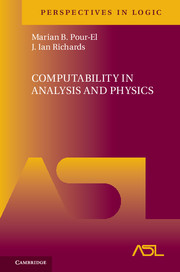Book contents
- Frontmatter
- Preface to the Series Perspectives in Mathematical Logic
- Authors' Preface
- Contents
- Maps
- Introduction
- Prerequisites from Logic and Analysis
- Part I Computability in Classical Analysis
- Part II The Computability Theory of Banach Spaces
- Chapter 2 Computability Structures on a Banach Space
- Chapter 3 The First Main Theorem and Its Applications
- Part III The Computability Theory of Eigenvalues and Eigenvectors
- Addendum: Open Problems
- Bibliography
- Subject Index
Chapter 3 - The First Main Theorem and Its Applications
from Part II - The Computability Theory of Banach Spaces
Published online by Cambridge University Press: 24 March 2017
- Frontmatter
- Preface to the Series Perspectives in Mathematical Logic
- Authors' Preface
- Contents
- Maps
- Introduction
- Prerequisites from Logic and Analysis
- Part I Computability in Classical Analysis
- Part II The Computability Theory of Banach Spaces
- Chapter 2 Computability Structures on a Banach Space
- Chapter 3 The First Main Theorem and Its Applications
- Part III The Computability Theory of Eigenvalues and Eigenvectors
- Addendum: Open Problems
- Bibliography
- Subject Index
Summary
Introduction
In this chapter we present the First Main Theorem. This theorem gives a criterion for determining which processes in analysis and physics preserve computability and which do not. A major portion of this chapter is devoted to applications.
Here by the term “process” we mean a linear operator on a Banach space. The Banach space is endowed with a computability structure, as defined axiomatically in Chapter 2. Roughly speaking, the First Main Theorem asserts:
bounded operators preserve computability,
and unbounded operators do not.
Although this already conveys the basic idea, it is useful to state the theorem with a bit more precision. The theorem involves a closed operator T from a Banach space X into a Banach space Y. We assume that Tacts effectively on an effective generating set {en} for X. Then the conclusion is: T maps every computable element of its domain onto a computable element of Y if and only if T is bounded.
We observe that there are three assumptions made in the above theorem: that T be closed, bounded or unbounded as the case may be, and that T acts effectively on an effective generating set. We now examine each of these assumptions in turn.
Consider first the assumption that T be bounded/unbounded. This assumption is viewed classically; it has no recursion-theoretic content. In this respect, the approach given here represents a generalization and unification of that followed in Chapters 0 and 1. In Chapters 0 and 1, we gave explicit recursion-theoretic codings —a different one for each theorem. The First Main Theorem also involves a coding, bujt this coding is embedded once and for all in the proof. In the applications of the Fitst Main Theorem, no such coding is necessary. Thus, in these applications, we are free to regard the boundedness or unboundedness of the operator as a classical fact, and the effective content of this fact becomes irrelevant.
Consider next the assumption that T be closed. The notion of a closed operator is standard in classical analysis. It is spelled out, with examples, in Section 1. However, if the reader is willing to assume the standard fact—that all of the basic operators of analysis and physics are closed—he or she could simply skip Section 1.
Information
- Type
- Chapter
- Information
- Computability in Analysis and Physics , pp. 93 - 120Publisher: Cambridge University PressPrint publication year: 2017
